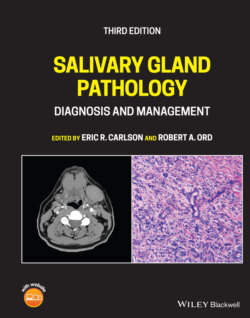Читать книгу Salivary Gland Pathology - Группа авторов - Страница 81
SUBMANDIBULAR GLAND
ОглавлениеThe submandibular gland (SMG) exists in the upper neck in the submandibular space (SMS) and the posterior oral cavity in the sublingual space (SLS). The SMG is more difficult to measure but the average adult superficial submandibular gland measures 3.5 cm in oblique AP, 1.4 cm in oblique LR, and 3.3 cm in SI dimensions. The gland “wraps” around the posterior border of the mylohyoid muscle and traverses the two spaces. The superficial portion is in the SMS adjacent to level one lymph nodes (level IB). The deep portion of the submandibular gland exists in the SLS. The SMS is bordered inferiorly by the hyoid bone and platysma and superiorly by the mylohyoid muscle. It is bordered laterally by the mandible and it is surrounded by the superficial layer of deep cervical fascia. Its medial border is a combination of the mylohyoid sling and anterior belly of the digastric muscle (Beale and Madani 2006) (Figures 2.37 through 2.43 ).
The submandibular duct emanates from the anterior‐superior aspect of the gland and turns anteriorly and lies along the superior surface of the mylohyoid muscle between the genioglossus muscle medially and the sublingual gland laterally. The ducts open into the anterior medial (paramidline) floor of mouth at the sublingual papillae.
On CT scans the submandibular gland has a density that is isodense to slightly hyperdense relative to skeletal muscle. The gland does not become as fatty replaced as the parotid gland. The SMG demonstrates a signal characteristic like that of skeletal muscle on T1 and T2 weighted images and is less intense when compared to the parotid gland secondary to less fatty replacement. The FDG uptake is moderate but higher than that of the parotid gland. The SMG undergoes contrast enhancement by CT and MRI (Kaneda 1996).
Figure 2.37. Axial CT at the level of the submandibular gland demonstrating density higher then skeletal muscle.
Figure 2.38. Reformatted coronal CT at the level of the submandibular gland demonstrating its relationship to the mylohyoid muscle and floor of mouth.
Figure 2.39. Reformatted sagittal CT at the level of the submandibular gland demonstrating its relationship to the floor of mouth. Note the slight notch at the hilum of the gland. Majority of the gland “hangs” below the mylohyoid muscle.
Figure 2.40. Axial T1 MRI of the submandibular gland demonstrating slight hyperintensity to muscle. Note the bright subcutaneous fat.
Figure 2.41. Coronal fat saturated T2 MRI of the submandibular gland. Note the slightly incomplete fat suppression and the engorged and edematous mucosa of the nasal cavity and turbinates.
Figure 2.42. Sagittal T1 fat saturated MRI of the submandibular gland demonstrating the well‐defined appearance on a fat suppressed background. Note the slight notch at the hilum. Note the entire internal jugular vein is visualized.
Figure 2.43. Axial CT (a) and corresponding PET (b) of the submandibular gland demonstrating slight normal uptake. Note the strong asymmetry of uptake on the PET corresponds to the absent submandibular gland on the right confirmed by the CT.
